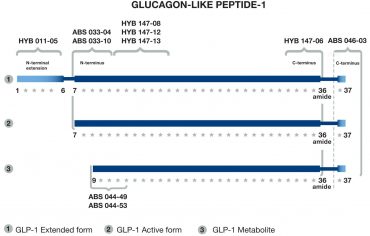BioPorto has the world’s leading portfolio of commercially available monoclonal antibodies against GLP-1. The antibodies towards GLP-1 were developed to target several epitopes in different forms (active, inactive, metabolic and total), with high specificity, enabling the selective analysis of different forms of GLP-1 in complex mixtures of closely related forms of the hormone. This gives valuable insight into the action mechanism of GLP-1 during the development of GLP-1-related treatments, in clinical phase I or in process and quality control of therapeutic products.
BioPorto offers two types of monoclonal antibody against exendin-4. The ABS 012 series (-20, -23, -24 and -35) were raised against intact exendin-4 and all bind to an epitope in the 9-39 region, mutually inhibiting each other’s binding. These antibodies do not cross-react with other glucagon-related peptides tested. The other antibody, ABS 033-10, was generated against an N-terminal fragment of GLP-1, but shows a 50% cross-reaction with exendin-4, presumably reacting with the free N-terminus. This antibody reacts with the intact active forms of GLP-1.
Download GLP-1 & Exendin-4 Brochure
GLP-1 and Exendin-4 Antibodies
GLP-1 analogues and Exendin-4 in Diabetis treatment
Diabetes is affecting up to 10% of the world’s population, and over 90% of these suffer from type 2 diabetes. In type 2 diabetes insulin is still being produced by the pancreas, but not enough to fully meet the body’s requirements. This opens the way to medicines which aim at increasing the remaining secretion of natural insulin from the pancreas.
Many therapies make use of the incretin effect: during food digestion the two gut-derived incretin hormones glucagon-like peptide-1 (GLP-1) and glucose-dependent insulinotropic polypeptide (GIP) naturally stimulate this glucose-dependent secretion of insulin from the pancreas. In healthy subjects this accounts for 50% – 70% of the total insulin secreted after oral food intake.
Chemical derivatives of GLP-1 are among the most powerful pharmacotherapies to treat type 2 diabetes and obesity. It is strongly documented that GLP-1 and related drugs lower blood glucose through an increase in glucose-dependent insulin secretion and a lowering of glucagon secretion. In addition, GLP-1 and related drugs lower body weight and systolic blood pressure and increase heart rate. The search for new insight into the molecular mode of action of GLP-1 is ongoing.
Exendin-4, a GLP-1-like peptide from Gila monster venom, is a naturally occurring long-acting GLP-1 receptor agonist. As such, it has been one of the prime candidates in new treatments for type-2 diabetes and obesity, along with derivatives either of itself or of GLP-1. An exendin-4 product (Exenatide) has in fact already been released for the treatment of type-2 diabetes. By stimulating glucose-dependent insulin secretion and exerting other effects on the gastrointestinal tract, exendin-4 and its analogues reduce the glycemic response to meals, and their use is also associated with weight loss.

